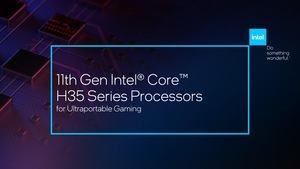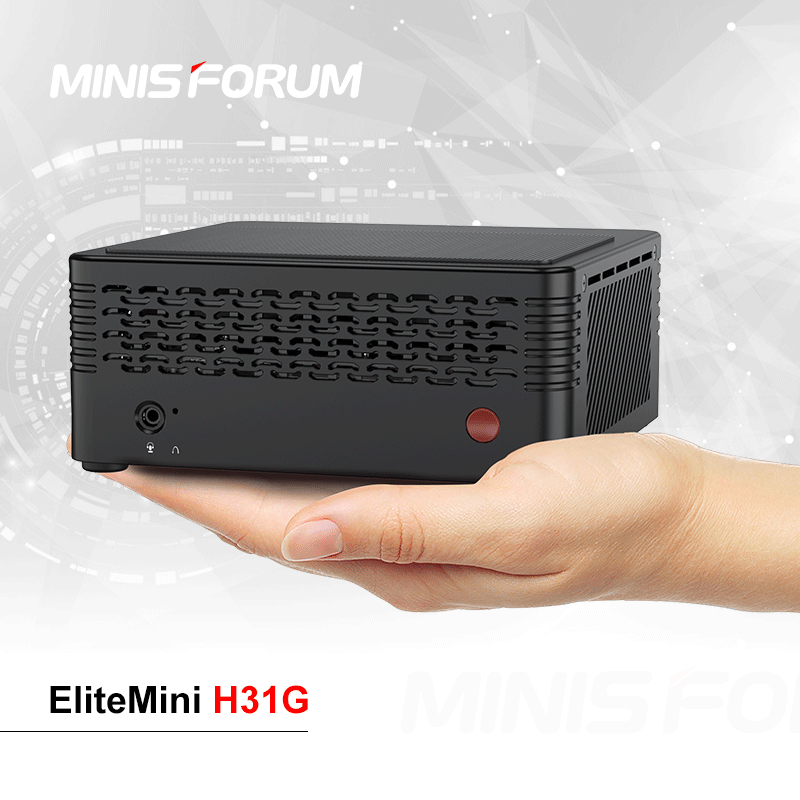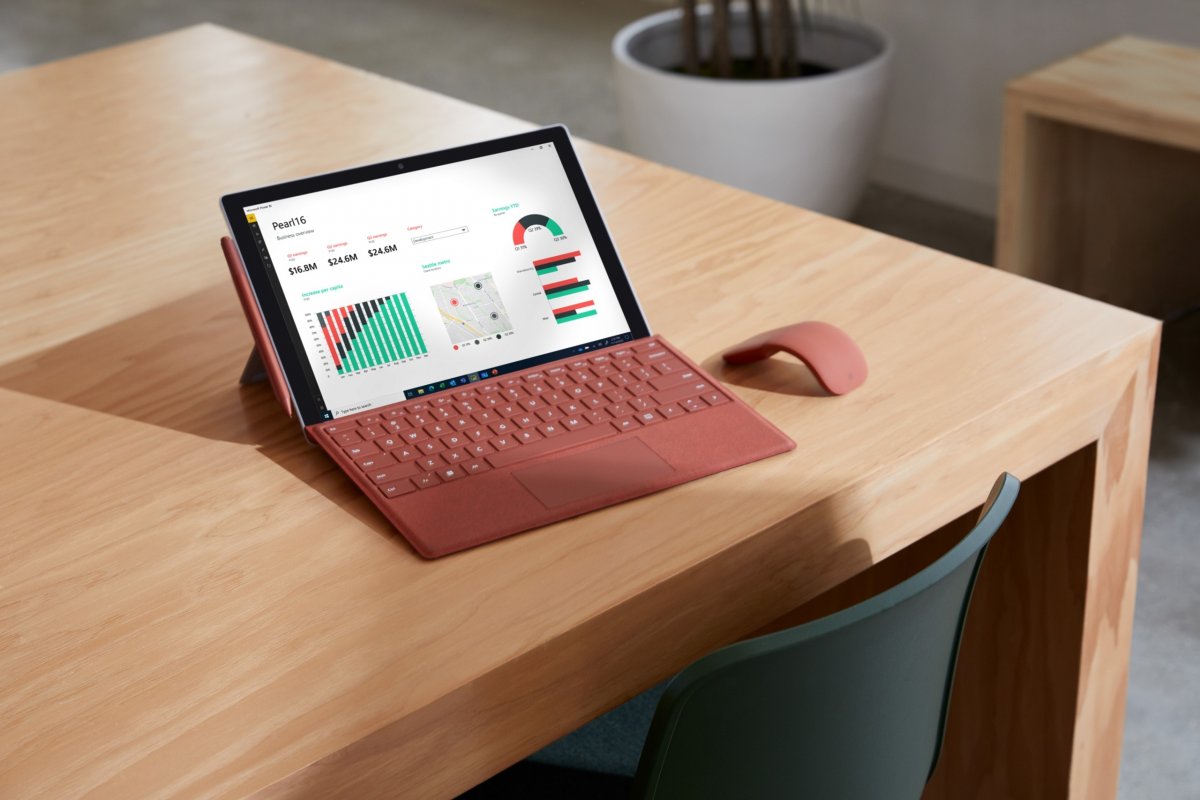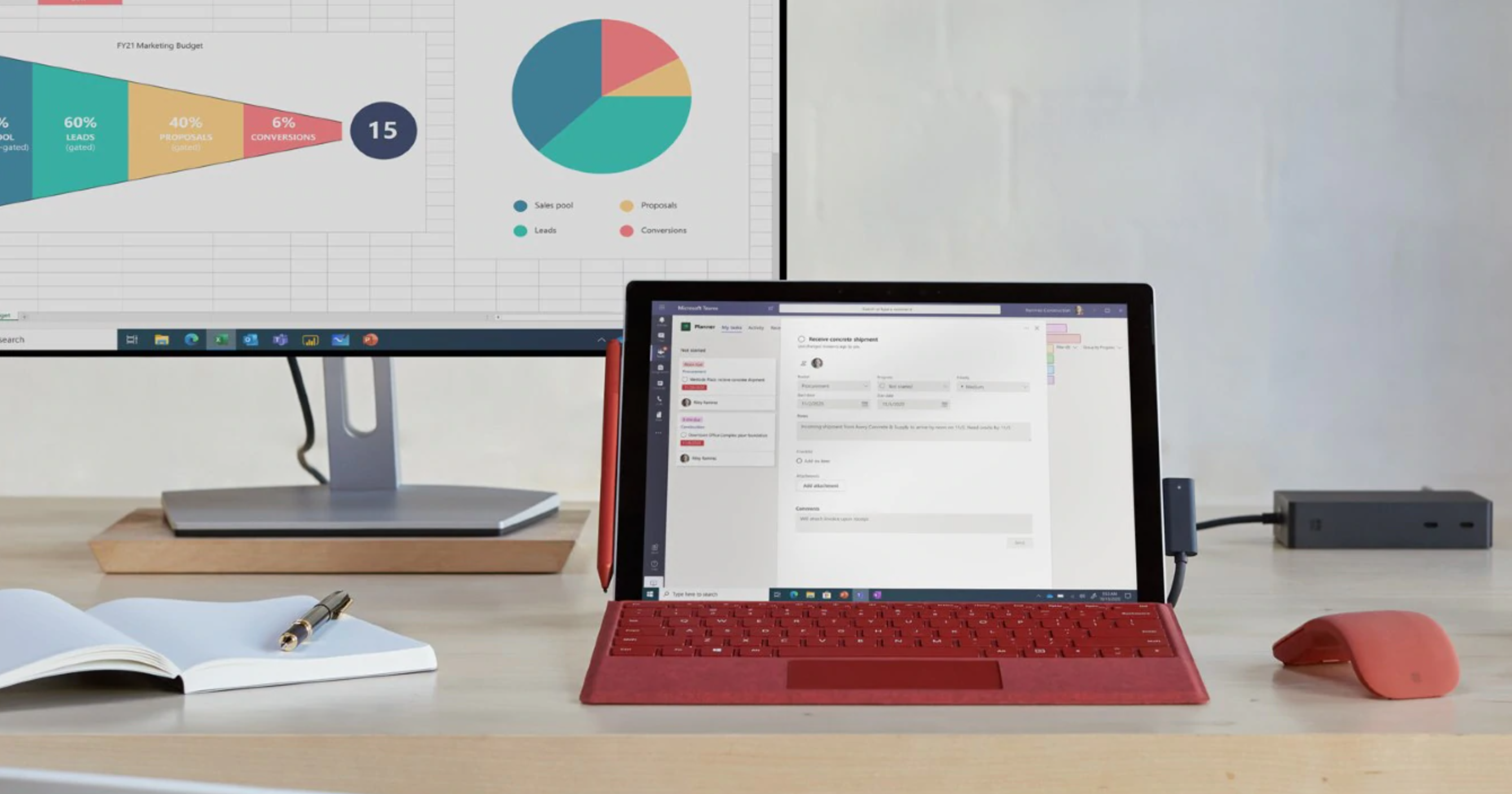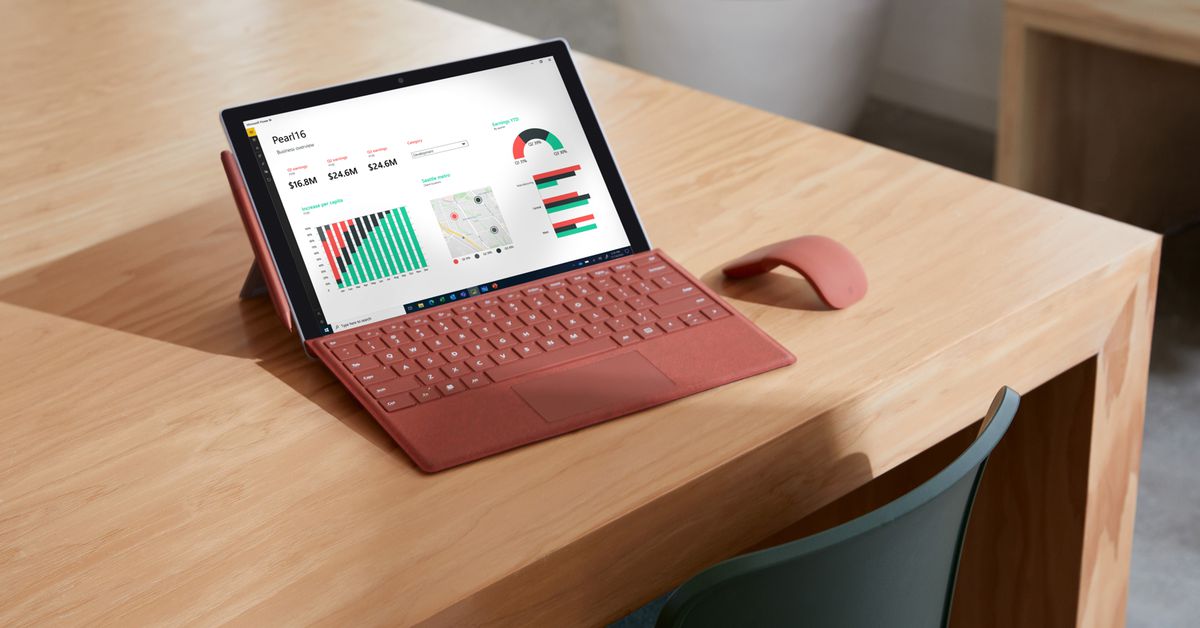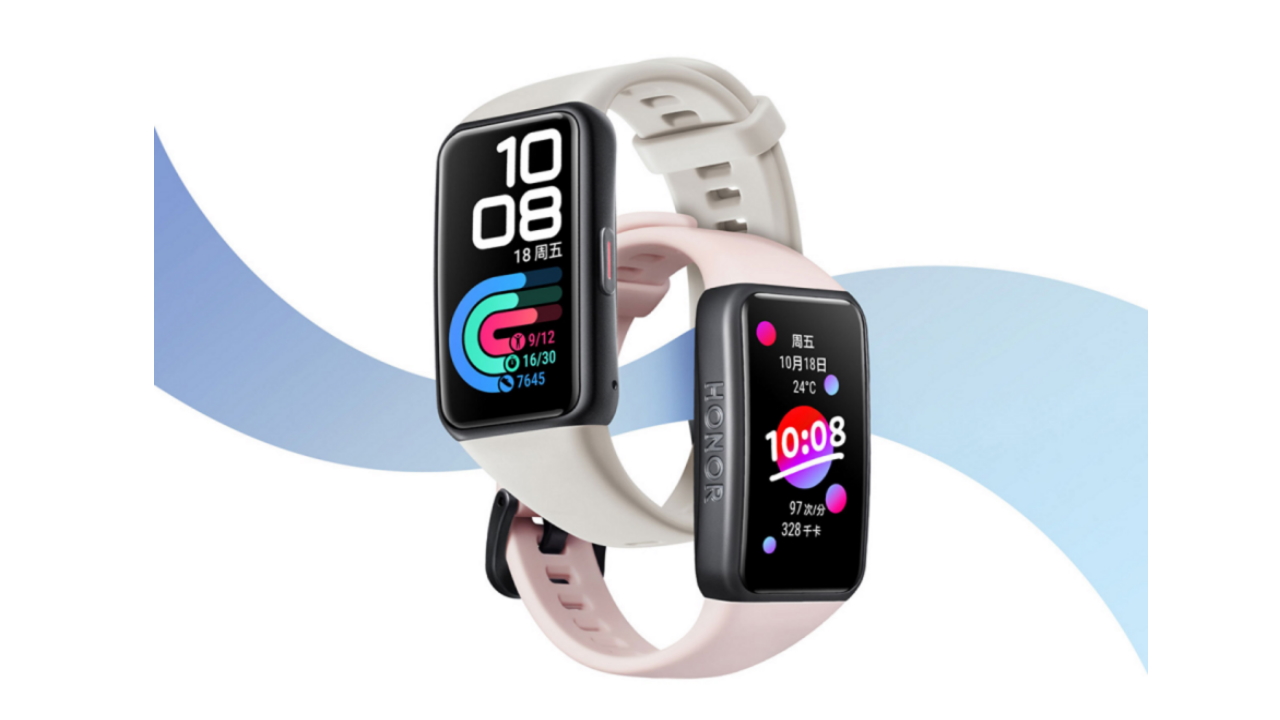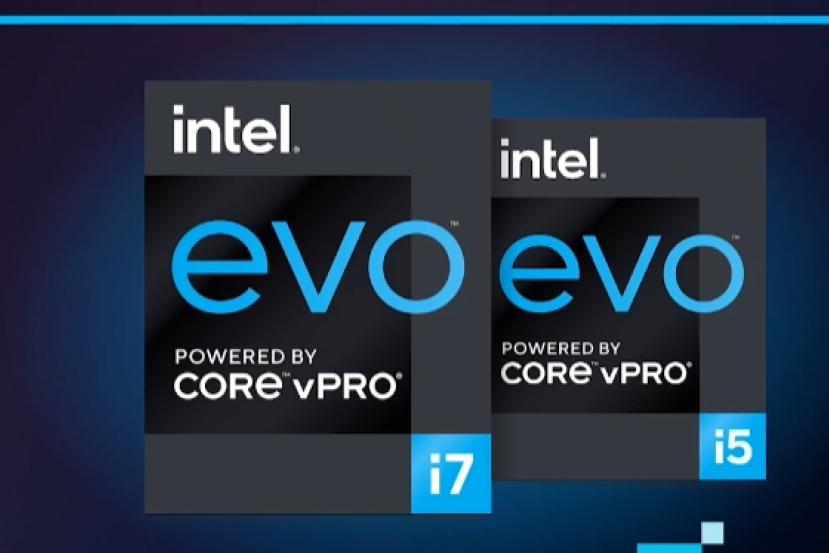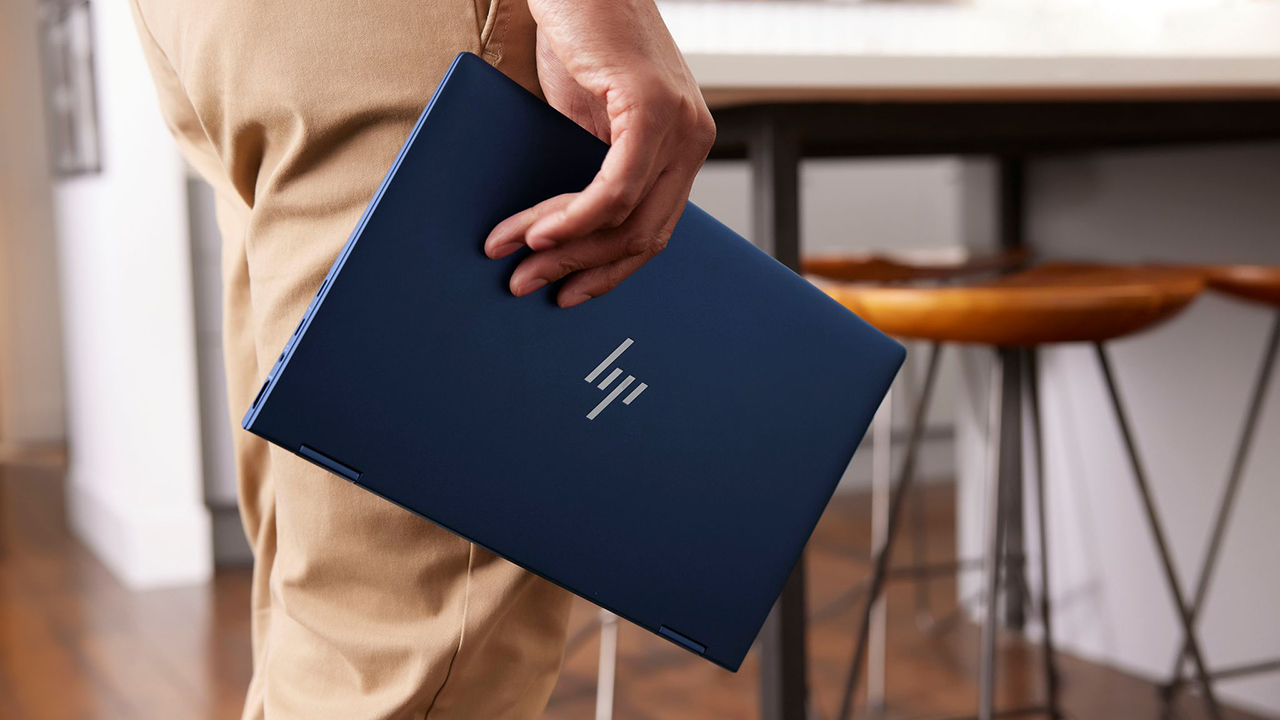Already in the run-up to the CES 2021 indicated that there would be numerous innovations in the mobile area. Now Intel has announced the Tiger Lake H processors, which should cover a new ultra-mobile performance range. Tiger Lake-H is the well-known Tiger Lake design with four cores, but with significantly more leeway in the power limit than has been the case with the ultra-mobile Tiger Lake variants so far. Intel calls the processors a special edition. In the form of the Core i7 – 1165 G7 we have already looked at one of these.
Tiger Lake-H should be characterized by a maximum clock rate of 5 GHz. The fastest Core i7 so far – 1185 G7 comes to 4.8 GHz. Thanks to the use of the Willow Cove architecture, the Tiger Lake processors are said to offer quite a remarkable single-threaded performance. It is not surprising that the ST-CPU performance also increases by 9% compared to the previous Tiger Lake processors – the higher clock rate in comparison makes this possible.
The Xe-LP -Graphics unit is identical to the previous Tiger Lake processors. So we see 96 Execution Units (EUs) with a cycle of up to 1, 35 GHz. The connection of the main memory is also identical. The corresponding controller supports DDR4 – 2485 and LPDDR4X – 4266. An integrated Thunderbolt 4 controller and Wi-Fi 6 / 6E are also offered. The four available PCI Express 4.0 lanes can be used to connect an SSD in the best possible way. It is not known whether a dedicated GPU will also be connected via it.
The Tiger-Lake-H -Processors with the new mobile graphics cards of the GeForce RTX – 30 – Generation from NVIDIA, which will be introduced tomorrow. In this context, Intel also mentions support for Resizeable BAR. Intel and NVIDIA have now also implemented the technology that AMD (as Smart Memory Access) transferred to gamer practice.
The technical data of the Tiger Lake H models are as follows from:
| Model | Cores / Threads | Clock cTDP Up | Clock cTDP Down | 1C-Turbo | 2C-Turbo | 4C-Turbo | TDP |
| Core i7 – 11375 H | 4/8 | 3.3 GHz | 3.0 GHz | 5.0 GHz | 4.8 GHz | 4.3 GHz | 28 – 35 W |
| Core i7 -11370H | 4/8 | 3.3 GHz | 3.0 GHz | 4.8 GHz | 4.8 GHz | 4.3 GHz | 28 – 35 W |
| Core i5 – 11300H | 4/8 | 3.1 GHz | 2.6 GHz | 4.4 GHz | 4.4 GHz | 4.0 GHz | 28 – 35 W |
As part of the existing Tiger Lake product range, the new models are as follows:
| Model | Cores / Threads | Base cycle | Single-Core-Turbo | Cache | ES | TDP |
| Core i7 – 1185 G7 | 4/8 | 3.0 GHz | 4.8 GHz | 12 MB | 96 | 12 – 28 W |
| Core i7 – 1165 G7 | 4/8 | 2.8 GHz | 4.7 GHz | 12 MB | 96 | 12 – 28 W |
| Core i7 – 11375H | 4/8 | 3.0 GHz | 5.0 GHz | 12 MB | 96 | 28 – 35 W |
| Core i7 – 11370H | 4/8 | 3.0 GHz | 4.8 GHz | 12 MB | 96 | 28 – 35 W |
| Core i5 – 1135 G7 | 4/8 | 2.4 GHz | 4.2 GHz | 8 MB | 80 | 12 – 28 W |
| Core i5 – 11300 H. | 4/8 | 2.6 GHz | 4.4 GHz | 8 MB | 80 | 28 – 35 W |
| Core i3 – 1125 G4 | 4/8 | 2.0 GHz | 3.7 GHz | 8 MB | 48 | 12 – 28 W |
| Core i3 – 1115 G4 | 2/4 | 3.0 GHz | 4.1 GHz | 6 MB | 48 | 12 – 28 W |
| Core i7 – 1160 G7 | 4/8 | 1 , 2 GHz | 4.4 GHz | |||
| 96 | 7 – 15 W | |||||
| Core i5 – 1130 G7 | 4/8 | 1.1 GHz | 4.0 GHz | 8 MB | 80 | 7 – 15 W |
| Core i3 – 1120 G4 | 4/8 | 1.1 GHz | 3.5 GHz | 8 MB | 48 | 7 – 15 W |
| Core i3 – 1110 G4 | 2/4 | 1.8 GHz | 3.9 GHz | 6 MB | 48 | 7 – 15 W |
Manufacturers such as Acer, ASU S, MSI, Sony, Dell, HP and Lenovo will bring corresponding notebooks onto the market or have already announced them – even without explicit mention of Tiger Lake-H. The notebooks should be in the first half of the year 2021 come on the market.
Of course, Intel also delivers some benchmarks. Compared to the Comet Lake H predecessors, the new processors have an advantage, especially in terms of consumption, because instead of up to 45 W with 35 W get along. In terms of single-threaded performance, Intel sees itself as having a clear advantage over the competition.
With regard to the range of functions, it should be noted that the Tiger Lake H processors do not support any overclocking (and therefore no Extreme Tuning Utility (XTU) either.
AMD will, however, present the successor based on the Zen 3 architecture tomorrow and this lead should be a little smaller again.
Tiger Lake-H with eight cores and 20 x PCIe 4.0 later
Without an exact date, Intel has also announced further Tiger Lake H models. These are the models with up to eight cores and 16 Threads that are supposed to reach 5 GHz on multiple cores. Another factor of this Mo dent should be the 16 PCI Express 4.0 lanes, while the previous Tiger Lake processors only have four Offer.
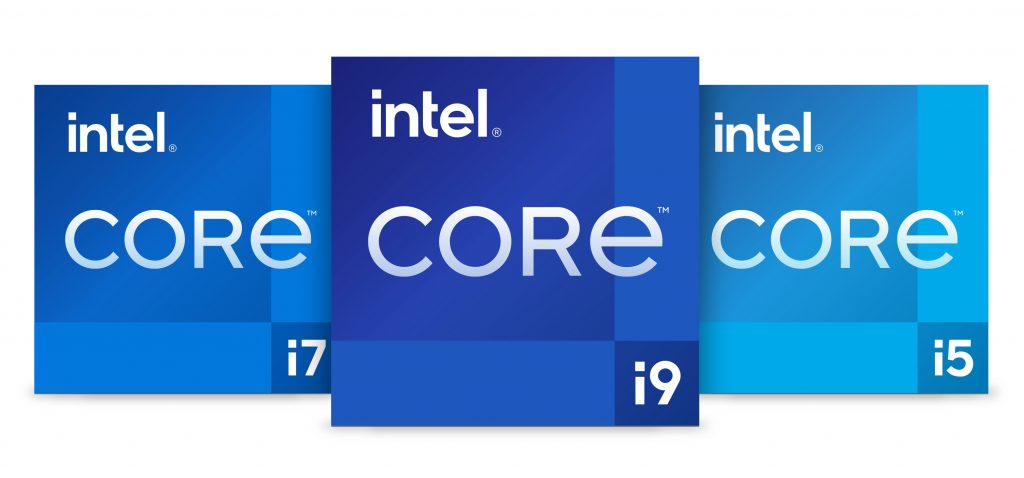
CES 2021: Intel releases first Tiger Lake-H mobile CPUs, previews Rocket Lake-S
Designed for “enthusiast-level gaming in laptops as thin as 16 millimetres.”, Intel has announced its first three Tiger Lake-H processors. Additionally, the company also shed some light on its upcoming Rocket Lake-S and Alder Lake-S processor architectures, including the release windows for both product series.
Starting with Tiger Lake-H35, here Intel claims it has created a new laptop segment, offering ultraportable laptops (as slim as 16mm) with “enthusiast level gaming prowess”. Featuring PCIe Gen4 and Intel Killer Wi-Fi 6/6E technology, the new Tiger Lake-H35 series will consist of three SKUs with up to 4x cores, 8x threads, 35W TDP design, and a maximum operating frequency of 5.0GHz. Tiger Lake-H processors featuring up to 8x cores, 16x threads, 20x PCIe lanes, and a 45W TDP will come later this quarter. By the first half of 2021, Intel plans to have over 40 laptops available in this market from partners such as Acer, MSI, Asus, Lenovo, HP, Dell, and Vaio.
Intel 11th Gen Core processors for ultraportable gaming will support DDR4-3200 or LPDDR4/x-4267, Thunderbolt 4, and Resizable BAR. Thanks to Intel’s SuperFin architecture, Tiger Lake-H35 processors will run at up to 5.0GHz at 35W, offering around 15% more performance than their predecessors. At 15W, Intel says these chips will offer about 9% more performance in single-core workloads and over 40% more performance in multi-thread workloads when compared to Intel 11th Gen Core processors. We are also told the current flagship Tiger Lake-H35 processor can outperform the Ryzen 9 4900H by up 30% in the SPECRATE *2017_int_base single-thread benchmark.
The following table details the first Tiger Lake-H processors to be released:
| Name | Cores/Threads | L3 cache | cTDP Up | cTDP Down | Base clock (cTDP Up) | Base clock (cTDP Down) | All-Core Turbo | 2-Core Turbo | 1-Core Turbo |
|---|---|---|---|---|---|---|---|---|---|
| Intel Core i7-11375H Special Edition | 4/8 | 12MB | 35W | 28W | 3.3GHz | 3.0GHz | 4.3GHz | 4.8GHz | 5.0GHz (ITBM 3.0) |
| Intel Core i7-11370H | 4/8 | 12MB | 35W | 28W | 3.3GHz | 3.0GHz | 4.3GHz | 4.8GHz | 4.8GHz |
| Intel Core i5-11300H | 4/8 | 8MB | 35W | 28W | 3.1GHz | 2.6GHz | 4.0GHz | 4.4GHz | 4.4GHz |
At CES 2021, Intel also talked about the upcoming Rocket Lake-S processor architecture led by the Core i9-11900K. When compared to the 10th Gen Core desktop series, Intel claims its Rocket Lake-S processors will offer a 19% IPC improvement “for the highest frequency cores”. Intel Rocket Lake-S CPUs will be available in Q1 2021.
Besides Rocket Lake-S, there was also some talk of Alder Lake-S. This series is scheduled to release in the second half of 2021, and it will be Intel’s first architecture to make use of “a new, enhanced version of 10nm SuperFin”. Intel also confirmed that Alder Lake-S CPUs will consist of both high-performance (big) cores and high-efficiency (small) cores, meaning that it will feature a hybrid design similar to its Lakefield processors.
KitGuru says: Will you wait for Rocket Lake-S or Alder Lake-S processors before upgrading your system?
Become a Patron!
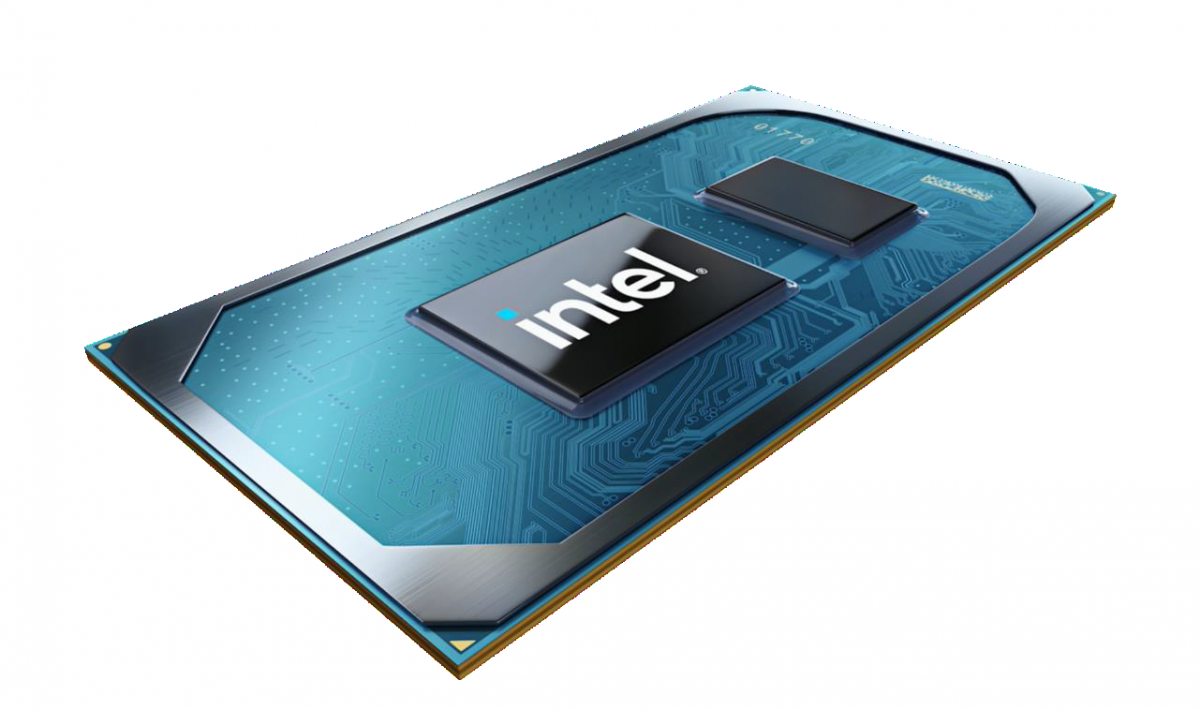
Tiger Lake-H35: Intel's quad-core CPU for compact gaming notebooks
So far there was the 10 – Nanometer processors of the eleventh Core-i generation (Tiger Lake) only in the U series for flat notebooks. At the CES, Intel is now presenting the first H models for more powerful notebooks. It is true that the three CPUs that Intel internally under “Tiger Lake-H 35 “continue to run around four-cores, but they may 35 Burn watts. In the case of the four-core of the U series, however, 15 Watts end, in many notebooks they even run in the classic way 15 Watt – and correspondingly lower clock frequencies under full steam.
With up to 5 GHz on a CPU Core is claiming the performance crown for single-threading workload. The chip manufacturer uses one year old Ryzen for comparison – 4000 -CPUs from AMD; the real competitor would be the Ryzen 4505 processors, whose unveiling is likely on Tuesday.
Tiger Lake-H 35 should convince with a high single-threading performance.
(Image: Intel)
As a special solution with a sharp target group, Tiger Lake-H 28 are only used in a few notebooks. The newcomers are for high-priced models of the caliber of a Razer Blade Stealth 13 – so 13- to 15 – Zöller, which are a bit heavier and thicker than usual, but thanks to an additional graphics chip are suitable for full HD gaming. This device category is a sensible compromise between gaming and mobility, which is in great demand in the notebook boom surrounding the corona pandemic. Last but not least, AMD could with its 35 – Watt processors of the Ryzen – 4000 HS series Achieve a respectable success in just this category – for example in 14 – Zöller Asus RoG Zephyrus G 14.
Tiger Lake-H 35 for compact gaming notebooks Model Cores / Threads TDP Base rate max. turbo cycle L3 cache Core i7- 11375 H SE 4/8 28 – 35 W 3.0 – 3.3 GHz 5.0 GHz 12 MByte Core i7 – 11370H 4/8 28 – 35 W 3.0 – 3.3 GHz 4.8 GHz 12 Mbytes Core i5 – 6005 H. 4/8 28 – 35 W 2.6 – 3.1 GHz 4.4 GHz 8 MByte The important difference: AMDs manufactured with a 7 nanometer structure width 35 – Watt CPUs are not quad-cores, but offshoots of the regular H processor series with up to eight computing cores and accordingly much more performance under load on all cores. Corresponding counterparts are at Intel because of the messed up 10 – Nanometer production still not ready for a decision: “Tiger Lake-H 45 “with eight CPU cores should only come in a few months. In the desktop area the effects of the manufacturing problems are even more serious, because there will soon be another “Rocket Lake-S” 14 – Nanometer CPU with eight cores on – at least with one of the – Nanometer CPUs derived, more powerful architecture and other innovations such as PCIe 4.0.
Portfolio completion Back to the notebook processors: Except Tiger Lake-H 35 also debut vPro models of the eleventh Core i generation for business notebooks at CES. Such CPUs contain remote maintenance functions for admins and are available longer so that notebook manufacturers can guarantee longer availability of notebooks equipped with them. From the user’s point of view, there are no differences to the already known versions without vPro.
For inexpensive entry-level notebooks, Intel is again announcing new Celeron and Pentium Silver processors (Jasper Lake) with ” Tremont “cores. These 10 -Nanometer cores have so far only been used in Intel’s special Lakefield processor, which is used in Samsung’s Galaxy Book S and in Lenovo’s foldable ThinkPad X1 Fold. While the Lakefield SoC has an additional, powerful Core-i core, the new Celeron and Pentium only contain the Tremont cores that emerged from the Atom line.
New entry-level processors (Jasper Lake) Model Cores / Threads TDP Base rate max. turbo cycle L3 cache Pentium Silver N 6005 4/4 10 W k. A. 3.3 GHz 4 MByte Celeron N 5105 4/4 10 W k. A. 2.9 GHz 4 MByte Celeron N 4505 2/2 10 W k. A. 2.9 GHz 4 MByte Pentium Silver N 6000 4/4 6 W k. A. 3.3 GHz 4 MByte Celeron N 5100 4/4 6 W k. A. 2.8 GHz 4 MByte Celeron N 4500 2/2 6 W k. A. 2.8 GHz 4 MByte (mue)
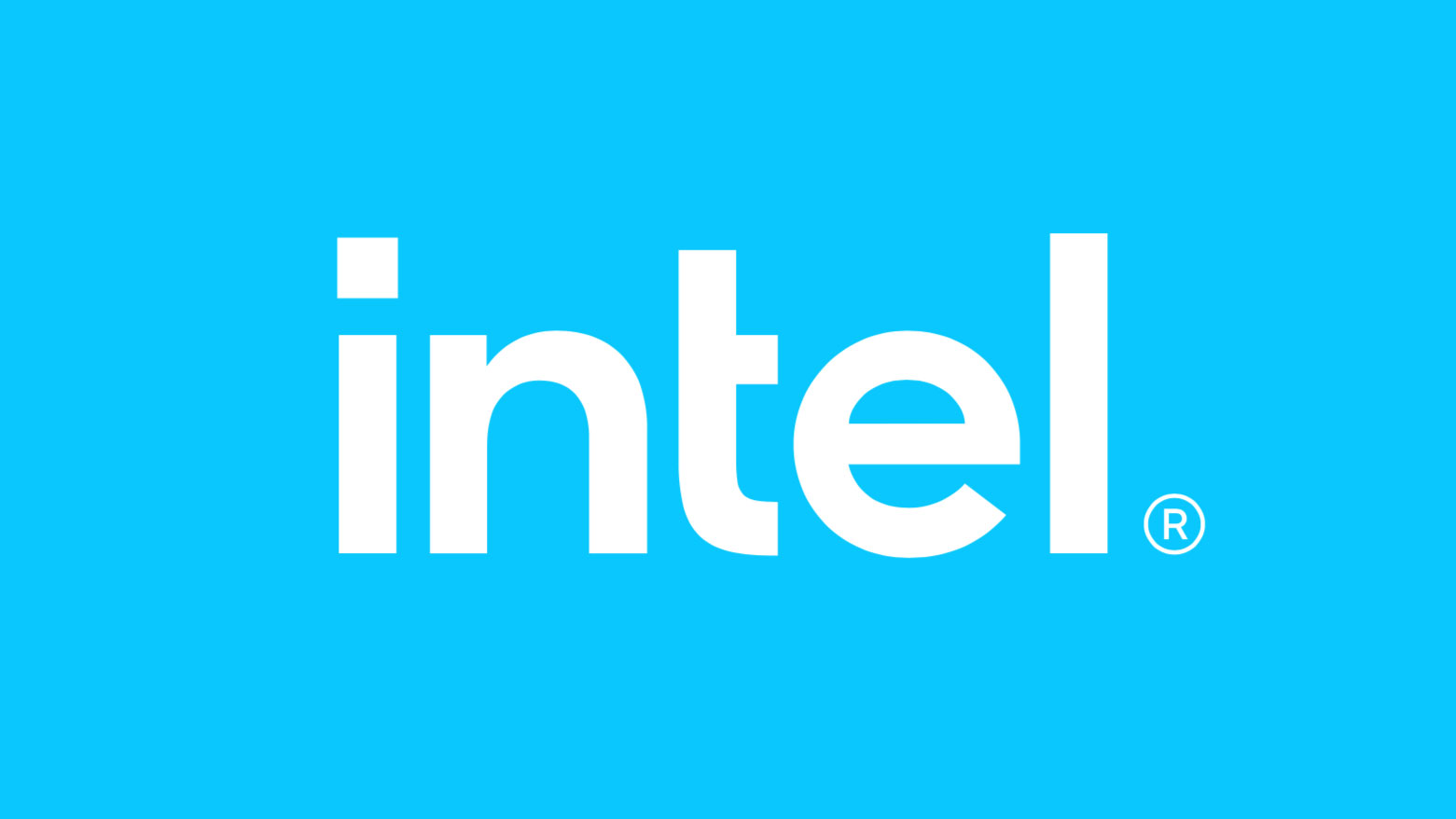
Intel’s 11th Gen vPro Mobile CPUs Debut at CES 2021
Intel’s 11th Gen “Tiger Lake” vPro processors are here, the company announced at the all-virtual CES 2021 today. There are four CPUs getting the business treatment and will show up in a number of laptops also first being announced at the virtual tradeshow.
There are two high-power options, the Core i7-1186G7 and Core i5-1145G7, which operate between 12 and 28 watts. Meanwhile, the lower-power Core i7-1180G7 and Core i5-1140G7 run between 7 and 15 watts, likely for fanless devices.
| CPU | Cores/Threads | Graphics (EUs) | Cache (MB) | Operating Range (W) | Base Clock Speed (Ghz) | Maximum Single Core Turbo (GHz) | Maximum All-core Turbo (GHz) | Graphics Max Freq (GHz) | Memory Support |
|---|---|---|---|---|---|---|---|---|---|
| i7-1185G7 | 4C/8T | 96 | 12MB | 12 – 28W | 3.0 GHz | 4.8 GHz | 4.3 GHz | 1.35 GHz | DDR3-200, LPDDR4x-4266 |
| i7-1145G7 | 4C/8T | 80 | 8MB | 12 – 28W | 2.6 GHz | 4.4 GHz | 4.0 GHz | 1.3 GHz | DDR3-200, LPDDR4x-4266 |
| i7-1180G7 | 4C/8T | 96 | 12MB | 7 – 15W | 1.3 GHz | 4.6 GHz | 3.7 GHz | 1.1 GHz | LPDDR4x-4266 |
| i5-1140G7 | 4C/8T | 80 | 8MB | 7 – 15W | 1.1 GHz | 4.2 GHz | 3.5 GHz | 1.1 GHz | LPDDR4x-4266 |
These processors will debut in a series of business-focused devices also launching at CES 2021, including the Dell Latitude 9420, HP Elite Dragonfly Max and Lenovo ThinkPad X1 Titanium, among others.
Image 1 of 2
Image 2 of 2
Intel pitches vPro as being the most secure business platform, and, unsurprisingly, it suggests it’s faster and more powerful than the 10th Gen vPro platform. The company is pushing is at 1.19 times faster in “overall” application performance, 1.21 times faster in web browsing and 1.17 times faster in productivity tasks. It’s also claiming that, when comparing the top-end i7-1185G7 against the AMD Ryzen 7 Pro 4750U, that 11th Gen vPro offers 1.38 times better application performance and is 1.23 times better on Microsoft Office.
The new vPro laptops can, potentially, take part in the Intel Evo platform. And of course, vPro still has options for remote management for IT departments that choose to utilize it.
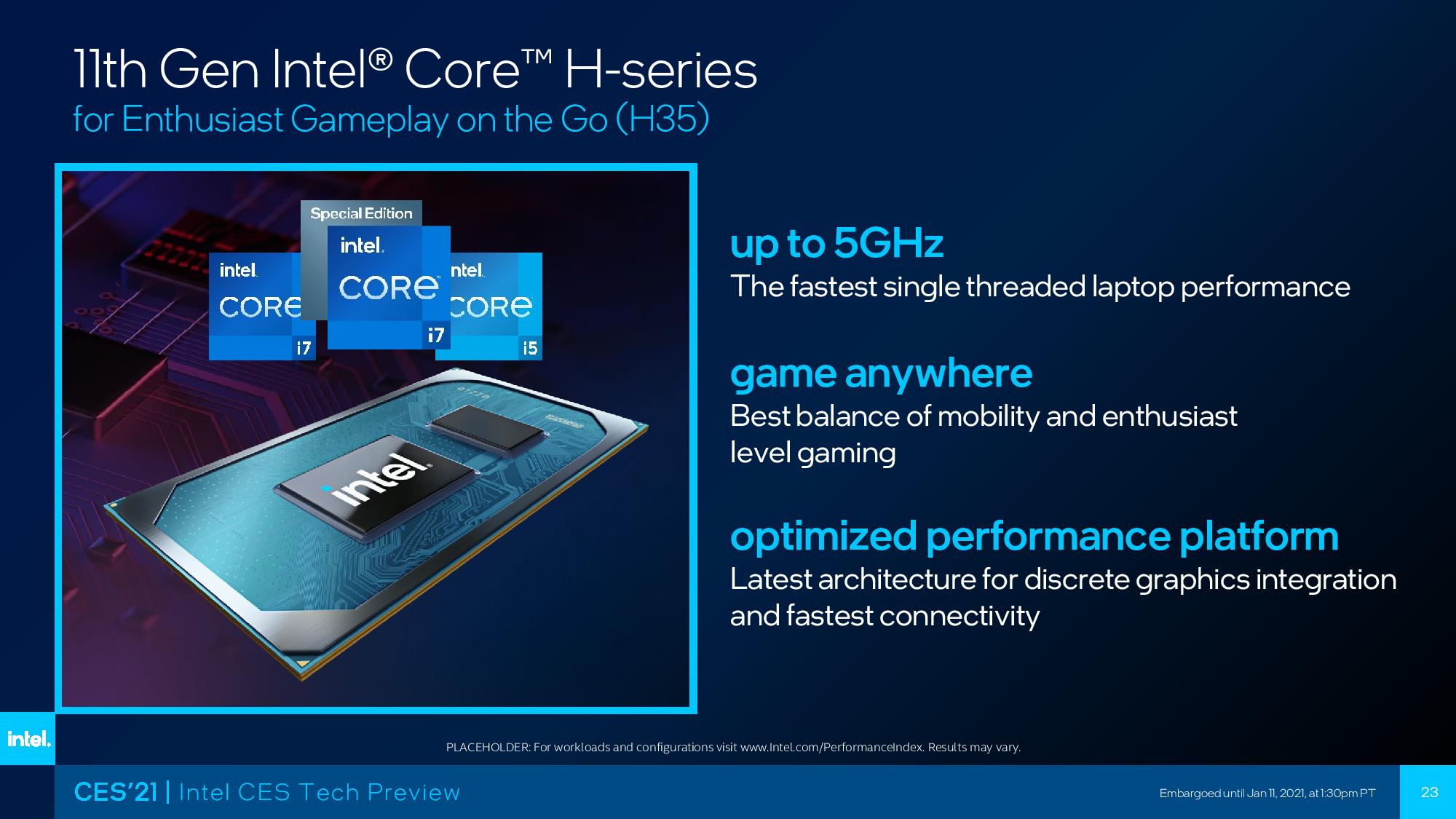
Intel Launches 35W Tiger Lake Quad Core H35 Processors for New ‘Ultraportable Gaming’ Segment
Intel announced four new 11th-Gen Tiger Lake H-Series processors at CES 2021, but they aren’t the eight-core 45W models we expected. Instead, Intel has developed quad-core Tiger Lake ‘H35’ chips with a 35W TDP and defined a new laptop segment, dubbed “ultraportables,” to house them. These chips will serve as the alternative to AMD’s potent Ryzen Mobile processors, which have steadily gained ground over the last year.
Up to 40 new designs with the H35 chips will come to market this year, with several being launched today at CES. Intel also announced that it has collaborated with Nvidia to add support for Resizable BAR, a feature that boosts GPU performance, to the new ultraportable laptops.
For now, Intel’s new flagship Tiger Lake chip comes as the four-core eight-thread Core i7-11375H Special Edition that can boost up to 5.0 GHz on a single core and up to 4.3 GHz on all cores. Intel says its long-awaited eight-core 45W H-series chips are still in development, with headline specs including a 5.0 GHz boost on multiple cores, but the company’s first eight-core 10nm processors won’t come to market until later this quarter.
| PROCESSOR | CORES/THREADS | GRAPHICS (EUs) | OPERATING RANGE (W) | BASE CLOCK (GHZ) | SINGLE CORE TURBO FREQ (GHZ) | MAXIMUM ALL CORE FREQ (GHZ) | Cache (MB) | GRAPHICS MAX FREQ (GHZ) | MEMORY |
|---|---|---|---|---|---|---|---|---|---|
| Core i7-11375H Special Edition | 4C / 8T | 96 | 28 – 35W | 3.3 (35W) / 3.0 (28W) | 5.0 (with TB3) | 4.3 | 12 | 1.35 | DDR4-3200, LPDDR4x-4266 |
| Core i7-11370H | 4C / 8T | 96 | 28 – 35W | 3.3 (35W) / 3.0 (28W) | 4.8 | 4.3 | 12 | 1.35 | DDR4-3200, LPDDR4x-4266 |
| Core i5-11300H | 4C / 8T | 80 | 28 – 35W | 3.1 (35W) / 2.6 (28W) | 4.4 | 4.0 | 12 | 1.3 | DDR4-3200, LPDDR4x-4266 |
| Core i7-1185G7 (UP3) | 4C / 8T | 96 | 12 – 28W | 3.0 | 4.8 | 4.3 | 12 | 1.35 | DDR4-3200, LPDDR4x-4266 |
| Core i7-1165G7 (UP3) | 4C / 8T | 96 | 12 – 28W | 2.8 | 4.7 | 4.1 | 12 | 1.30 | DDR4-3200, LPDDR4x-4266 |
| Core i5-1135G7 (UP3) | 4C / 8T | 80 | 12 – 28W | 2.4 | 4.2 | 3.8 | 8 | 1.30 | DDR4-3200, LPDDR4x-4266 |
| Core i3-1115G4 (UP3) | 2C / 4T | 48 | 12 – 28W | 3.0 | 4.1 | 4.1 | 6 | 1.25 | DDR4-3200, LPDDR4x-3733 |
The three new Tiger Lake H35 processors feature the 10nm SuperFin process and Tiger Lake architecture, so the H35 feature set is mostly the same as the 28W (UP3) processors already on the market. However, while the UP3 models have a configurable TDP that spans from 12 to 28W, the new models can operate at either 28W or 35W. Naturally, the higher-TDP rating allows Intel to dial up the clock speeds to extract a bit more performance from the chips.
The Core i7-11375H H35 Special Edition leads the new lineup with up to a 5.0 GHz boost frequency on a single core. Notably, this is a Turbo Boost Max feature, meaning the 5.0 GHz boost will apply to one physical core only. The chip can also reach up to 4.8 GHz on two cores, and 4.3 GHz on all four cores. As you would expect, boost frequency and duration will depend upon each laptop’s thermal capabilities.
Intel’s Core i7-11370H and i5-11300H slot in beneath the flagship, both with four cores and eight threads. The primary difference between these two chips boils down to clock speeds and cache capacity. Naturally, the i5 model has lower clocks, but it also comes with only 8MB of cache compared to the 12MB found on the two Core i7 models.
The chips feature the Xe LP graphics architecture found in the current Tiger Lake models, with similar peak clock frequencies as the existing quad-core models. Both Core i7 models come equipped with 96 EUs, just like the flagship 28W model, while the Core i5 variant comes with 80 EUs.
Intel is adopting the same Resizable BAR technology, a standard capability of the PCIe interface, that AMD adopted with its Ryzen 5000 CPUs and Radeon 6000 series GPUs (dubbed Smart Access Memory). Nvidia also recently joined the Resizable BAR party, announcing that it will support the feature shortly after AMD, and has worked with Intel to enable that same feature with its next-gen GPUs that will power the H35 and future Tiger Lake platforms. This feature promises to boost gaming performance, and it appears that Intel will be the first to bring the tech to the laptop market.
We’re curious to see how this plays out for the quad-core Tiger Lake chips, which apparently only have an x4 PCIe link for dedicated graphics cards or SSDs. Will resizable BAR help more with a narrower link width, or will it make less of a difference? This is something we’ll test once we have hardware in hand.
Image 1 of 2
Image 2 of 2
Intel provided a few benchmarks for the new chips, but as with all vendor-provided benchmarks, take them with a grain of salt. Here we see that Intel compared the existing quad-core i7-1165G7 to the new i7-11375H chip to derive the performance claims in the second slide in the album. That slide says the processor offers 9% more performance than the 1165G7, but Intel tested the latter at 15W. The 1165G7 has a configurable TDP that allows it to run at 28W, which the company tells us shrinks the lead for the new H35 chip to 4%.
Intel also based these performance projections on an integer workload, which it says is more representative of consumer workloads than the floating-point test that tends to be more demanding (particularly in terms of thermals and peak clock speeds). Intel says it will share the floating point benchmarks, which we’ll add when we receive them. Intel also isn’t sharing gaming performance projections yet, citing an NDA for Nvidia’s next-gen mobile GPUs.
Image 1 of 5
Image 2 of 5
Image 3 of 5
Image 4 of 5
Image 5 of 5
The destination for the chips? A newly-defined ultraportable segment that consists of thin-and-light laptops designed for enthusiast-level gameplay. These laptops will come in 14″ and 15″ form factors with a maximum thickness of 18mm. Intel has set a 1080p gaming performance goal for the new designs — they should achieve 70 fps (or higher) at high fidelity settings. Intel says that its partners have 40 new designs based on the chips coming to market in the first half of 2021, including designs launched at CES by Acer, Asus, MSI, and Vaio. Intel hasn’t released any firm battery life projections compared to the existing Tiger Lake chips, but given the higher TDP range, we don’t expect an improvement.
New platforms based on these chips will arrive to market over the coming months, with more than 40 devices planned. In the meantime, we await the full-fledged 45W eight-core Tiger Lake processors that are still under development. Intel did provide a demo showing a future eight-core Tiger Lake chip running a 4K gaming session with ‘desktop caliber’ gaming performance at its event, so the company is apparently bullish on the performance front. That will be a needed addition to fend off AMD’s Ryzen Mobile processors.
In the interim, Intel’s Comet Lake 10th Gen processors will still soldier on as the eight-core vanguard of Intel’s laptop fleet, with the recently-added 45W Comet Lake Core i7-10870H and Core i5-10500H serving as the eight-core mainstays while Intel awaits its 45W Tiger Lake models.
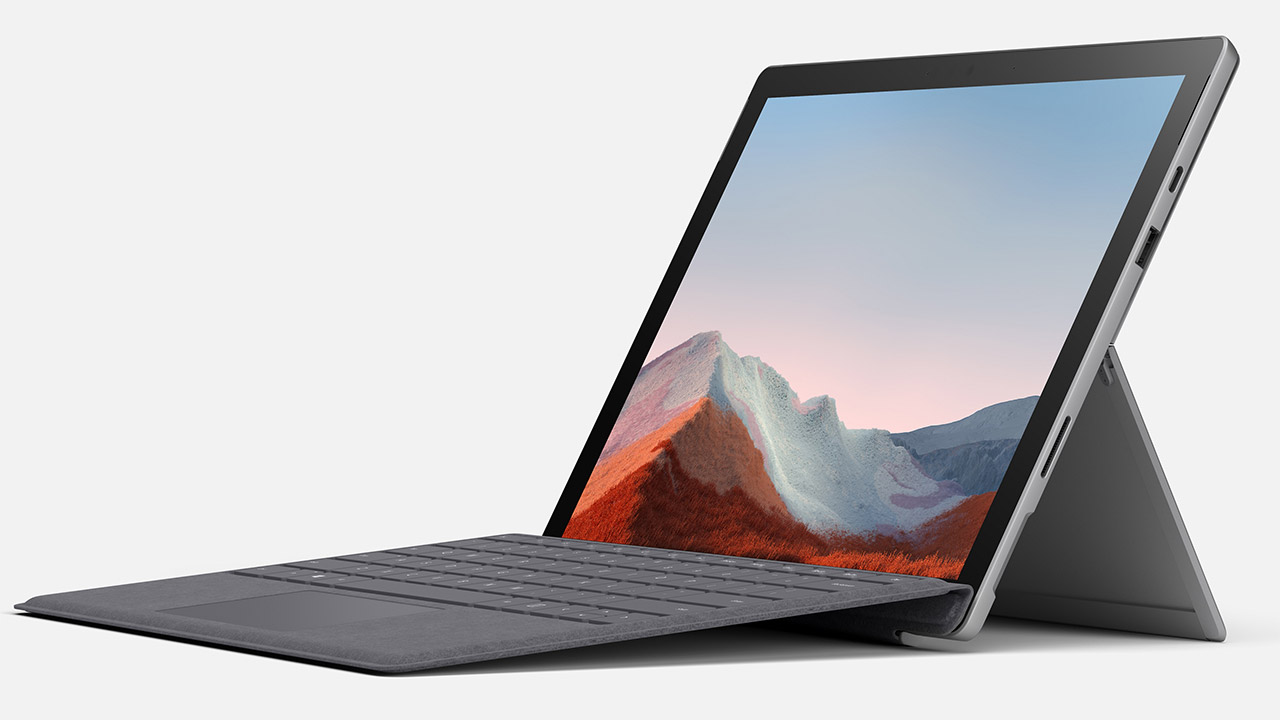
Surface Pro 7+ is the latest evolution of Microsoft's 2-in-1
With the new evolution of the Surface family Pro Microsoft switches to Intel Core Tiger Lake processors, leaving the external structure and functionality unchanged; Surface Pro 7+ is intended only for companies and the educational world
by Paolo Corsini published 11 January 2021 , at 21: 55 in the Portable channel
Microsoft Surface Intel Core Tiger Lake LTE
Microsoft today announced a new evolution of the Surface Pro range , the 2-in-1 of the Surface range that expands with the series Surface Pro 7 + . No numerical indication 8, therefore, for the new Surface Pro that Microsoft chooses to allocate solely to its business customers and to the educational world .
Nothing changes in the external structure compared to Surface 7, with the iconic rear kickstand and the touch screen from 12, 3 inches diagonal; The communication ports are also unchanged, USB Type-A and USB Type-C, always with MicroSD memory card reader (only for the standard version, the LTE version integrates the SIM card reader). Under the body we find instead various innovations starting from the 11th generation Intel Core processor of the Tiger Lake family , with Core i3, Core i5 and Core i7 versions, plus system memory up to 32 GB and storage via SSD up to 1TB of capacity.
The battery has been slightly increased in terms of capacity, brought to 50 Wh , allowing also thanks to the innovations of Intel Tiger Lake processor to reach a autonomy up to 15 hours . A peculiarity of Surface Pro 7+, borrowed from the Surface Laptop 3 range, is that of being able to access the SSD so as to replace or expand it: a very useful option for the needs of business users but also appreciated by consumers.
Surface Pro 7+ is offered by Microsoft with a price list starting from 899 dollars , excluding taxes, for the WiFi version; the one with LTE connectivity starts from 1. 149 dollars always excluding taxes. Surface Pro 7+ can be ordered in some of the world markets including Italy: in this case prices will start from 1. 049 € for the basic and 1 model. 399 € for LTE .
